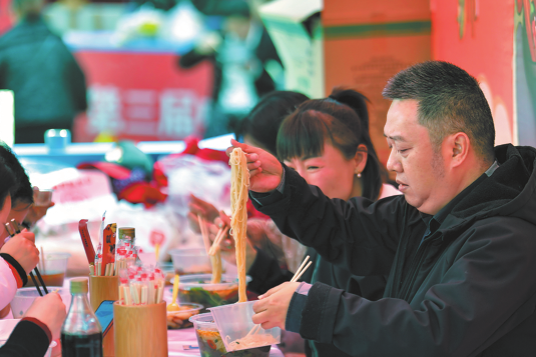Stringing an instrument along

One Chinese character forms the foundation of naming all stringed musical devices
In the world of Chinese instruments, one character plays a larger role than all the rest.
Until the 1920s, the character 琴 (qín) had a very specific meaning - it was used to only refer to the 古琴 (gǔqín), an ancient Chinese instrument. Today, however, 琴 can be used to refer to any musical instrument that has strings. Ironically, its leap in status to cover all musical instruments came about due to its "marriage" with a Western instrument after distinctions arose when people needed to make clear they were referring to a different instrument: the 钢琴 (gāngqín), known to the rest of us as the piano.
| A woman plays guqin, the ancient Chinese instrument, in Fuzhou, capital of Fujian province. Provided to China Daily |

The character 琴 was once written as shown in the left picture, as an almost exact side view of the instrument. The two vertical strokes resemble the strings, and the horizontal strokes resemble the capos and the curved stroke draws the outline of the resonance chamber. The current form 琴 is simply a pictophonetic character (形声字 xíngshēng zì).
The character has plenty of, well, character, and as such there are many stories about it.
It is said that in the Spring and Autumn period (770 to 476 BC), there was a famous performer, Bo Ya, who came across someone with an eerily talented ear, named Zhong Ziqi.
As Bo thought about the lofty mountains, Zhong was immediately able to tell what he was thinking about from the music. When Bo was thinking about flowing water, Zhong again read Bo's thoughts. Whatever Bo played, Zhong was immediately able to read his mind. This earned him the reputation of being called a 知音 (zhīyīn), someone who understands the music, hence a bosom friend. When Zhong died, Bo broke his instrument and was determined never to play it again, because he had lost his 知音. Today we still have those two pieces of music 《高山 》 (gāoshān), lofty mountains, and 《流水 》(liúshuǐ), flowing water.

Another popular piece of 古琴 music,《酒狂》(jiǔkuáng), which literally means drunken ecstasy, is said to have been composed by the rabble-rousing idealist Ruǎn Jí, who was one of the Seven Sages of the Bamboo Grove in the Eastern Jin Dynasty (AD 317-420). In addition to his famed poetry and outspokenness, he was also known far and wide as a drunk. As the story goes, on one occasion he drank so much he was "dead drunk" for 60 consecutive days, which was actually part of a ploy to avoid being tied into a marriage with the royal family, which in his eyes evidently came with too many strings attached.
By putting 琴 and a similar musical instrument called 瑟 (sè) together, along with the word for harmony (和谐 héxié), the idiom 琴瑟和谐 is created, which means that the sound of both instruments is in concord, and thus also means marital harmony.
琴 is a symbol of noble culture and there are idioms to reflect how it should be respected. One points out that eating a beautiful animal like a 鹤 (hè), crane, or burning a beautiful instrument like the 琴, represents the destruction of beauty. Thus to 煮 (zhǔ), stew the crane and 焚 (fén), burn the 琴, or 煮鹤焚琴 (zhǔ hè fén qín) means to utterly ruin something good.
As a general term, the 琴 can also be used to create many compound words. By combining it together with 钢 (gāng) steel, you get piano (钢琴). If you combine it with 口 (kǒu), mouth, you get a harmonica (口琴). Combining it with 电子 (diànzǐ), electronic, you get an electronic organ (电子琴), and with 小 (xiǎo) small, and 提 (tí), lift up, you get violin (小提琴). By adding it to 竖 (shù), vertical, you can create a harp (竖琴).
Courtesy of The World of Chinese, www.theworldofchinese.com
The World of Chinese
(China Daily European Weekly 12/19/2014 page27)
Today's Top News
- Japan tempting fate if it interferes in the situation of Taiwan Strait
- Stable trade ties benefit China, US
- Experts advocate increasing scope of BRI to include soft power sectors
- New engine powers cargo drone expansion
- China to boost green industry cooperation
- Manufacturing PMI rises in November































